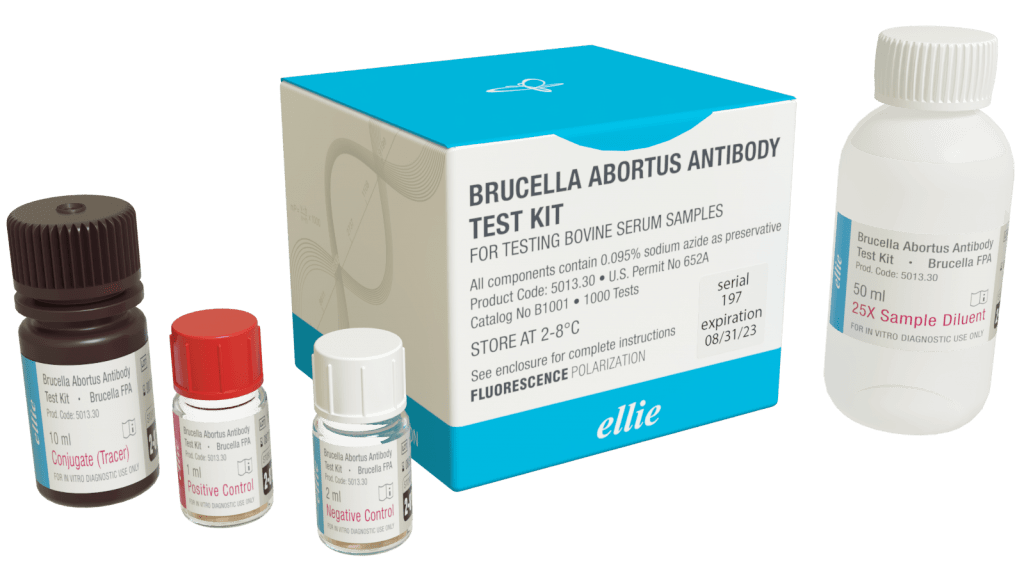Brucella FPA
The most advanced brucellosis diagnostics in the world!
The Brucella FPA is the test of choice for the largest successful brucellosis eradication campaigns in the world.
Brucella FPA
The most advanced brucellosis diagnostics in the world!
The Brucella FPA is the test of choice for the largest successful brucellosis eradication campaigns in the world.

General
Information
OPS test
Assay time 5 min
Multi species test
Test of choice for vaccinated animals
Comparison
to other technologies
The Brucella FPA measures an antibody response against the OPS part of the lipopolysaccharide (LPS) molecule. In contrast, RBT, ELISA, and most cELISA kits detect long-lasting antibody responses to the entire LPS including Lipid A and the core oligosaccharide. In addition, FPA does not amplify the signal; therefore, it is a semi-quantitative system for measuring Brucella activity in an animal. This greatly enhances our ability to distinguish between animals that were infected with field strains or vaccines and those that were able to clear an infection.
READY TO FIGHT BRUCELLOSIS? MAKE THAT CALL!
Test of choice for vaccinated animals
There is great controversy regarding the ability of certain technologies to distinguish vaccinated from infected animals. However, animals can be infected with a vaccine. Thus, instead of discussing a technology that can distinguish between vaccinated and field-infected animals, we should be discussing a technology that can identify animals that have been infected from those who have or are successfully clearing the infection. An older version of the O.I.E. Manual for Diagnostic Tests and Vaccines claims a cELISA test can be used for such a purpose. But the claim was ambiguously written and is essentially not true. In some papers, FPA is mentioned as a test that can distinguish vaccinated and infected animals. But in the case of a single animal, this statement is also not true. FPA can, however, detect short-lived OPS responses, which present positive results that correlate with the severity of an infection. When applied to an animal population, FPA can determine if a vaccine has been properly administered and which animals present a risk.
Animals can clear a transient infection within a few months after vaccination. Therefore, FPA will show negative results early for those animals. Other LPS-based tests will display long-lasting positive results even after the infection has cleared. For this reason, FPA has been successfully used in eradication campaigns where animals were vaccinated with smooth strain vaccines.
With respect to RB51, FPA does not give positive results on animals that have successfully cleared the infection; therefore, it works as a DIVA system. Animals are much more successful at clearing RB51 than a smooth strain vaccine. A combination of RB51 and FPA is the state-of-the-art system for brucellosis eradication in cattle today. This type of system still does not exist for small ruminants.
Brucella FPA
Performance in different situations
Graph 1 Negative population
Graph 1 shows that in a negative population, vaccinated with RB51 vaccine, no signals are detected. The results are very clear and unambiguous.
Millions of tests have been performed on animals in similar setup and the Brucella FPA consistently displays maximum specificity.


Graph 2 Successful vaccination
Graph 2 shows results from a farm that was successfully vaccinated with the Strain 19 vaccine. Some animals show a medium-positive signal, but there are no high-positive animals. Medium-positive animals are having difficulty clearing the infection and should be considered a risk to the population and managed separately or removed/milked out. Frequent testing of the herd will eventually lead to full clearance of the vaccine infection and successful immunization.
Graph 3 Unsuccessful vaccination
Graph 3 shows the results of an A19 vaccination administered on a negative population. This has caused many animals to be infected with the brucellosis vaccine. In this case, too many vaccinations were administered, especially to the adult population. If vaccination is not followed by testing, there is a high risk of developing a slow-moving, vaccine-induced brucellosis outbreak. A hallmark of this situation is an outbreak of brucellosis among farm workers.


Graph 4 Positive non-vaccinated population
Graph 4 shows results from a non-vaccinated, positive farm. Typically, a lot of animals show high-positive results: all samples above a titer of 20 ΔmP are true positives.
PERFORMANCE
There are numerous reports that discuss the specificity and sensitivity of the Brucella FPA. Tables shown here display results of our own studies on defined sets of positive samples and well-defined negative samples from a negative population. The specificity of the Brucella FPA is over 99%. The most recent USDA’s report on the specificity of the testing system, reported at the Annual Meeting of the United States Animal Health Association in 2017, places specificity at 99.994%. This system consists of an automated RBT screening and FPA confirmation testing. Contact us for more information.
|
Bovine serum samples (B1001) True status | |||
|---|---|---|---|
| Positive | Negative | ||
| Test results | Positive | 205 | 1 |
| Negative | 2 | 1009 | |
| Sensitivity 99% | Specificity 99.9% | ||
|
Sheep serum samples (B1002)
True status | |||
|---|---|---|---|
| Positive | Negative | ||
| Test results | Positive | 86 | 0 |
| Negative | 0 | 597 | |
|
Sensitivity 100% |
Specificity 100% | ||
|
Bovine serum samples (B1002)
True status | |||
|---|---|---|---|
| Positive | Negative | ||
| Test results | Positive | 105 | 0 |
| Negative | 0 | 92 | |
|
Sensitivity 100% |
Specificity 100% | ||
Ordering
Information
| Trade name | Brucella FPA |
|---|---|
| Technology | Flourescence Polarization Assay (FPA) |
| Antigen | Brucella abortus OPS |
| Analyte | Ig all classes |
| Species | Bovine, bison, buffalo, cervids |
| Samples | Serum, plasma and individual milk samples |
| Ordering information | B1001- 250 (250 tests kit) B1001- 1000 (1000 tests kit) |
| Trade name | Brucella FPA II |
|---|---|
| Technology | Flourescence Polarization Assay (FPA) |
| Antigen | Brucella abortus (A) and Brucella melitensis (M) OPS |
| Analyte | Ig all classes |
| Species | All animals including marine mammal |
| Samples | Individual serum and milk samples |
| Ordering information | B1002- 250 (250 tests kit) B1002- 1000 (1000 tests kit) |
| Trade name | Brucella FPA Medical |
|---|---|
| Technology | Flourescence Polarization Assay (FPA) |
| Antigen | Brucella abortus (A) and Brucella melitensis (M) OPS |
| Analyte | Ig all classes |
| Species | Human |
| Samples | Individual serum samples |
| Ordering information | B1003-250 (250 tests kit) |
This product is a qualitative test that uses Fluorescence Polarization technology to detect the presence of antibodies specific for smooth colony-producing Brucella species (B. melitensis, B. abortus, and B. suis – Rev. sci. tech., OIE 1982) in patient serum. The presence of antibodies is indicative of a prior Brucella infection.
| Trade name | Brucella FPA Milk |
|---|---|
| Technology | Flourescence Polarization Assay (FPA) |
| Antigen | Brucella abortus (A) and Brucella melitensis (M) OPS |
| Analyte | Ig all classes |
| Species | Bovine |
| Samples | Individual and bulk milk samples |
| Ordering information | B1004- 250 (250 tests kit) |
This product is a qualitative test that uses Fluorescence Polarization technology to detect the presence of antibodies specific for smooth colony-producing Brucella species (B. melitensis, B. abortus, and B. suis – Rev. sci. tech., OIE 1982) in individual or bulk milk samples. It can be performed in the field, and it is used on smaller farms to quickly assess the problem. The presence of antibodies is indicative of a current or recent Brucella infection.
